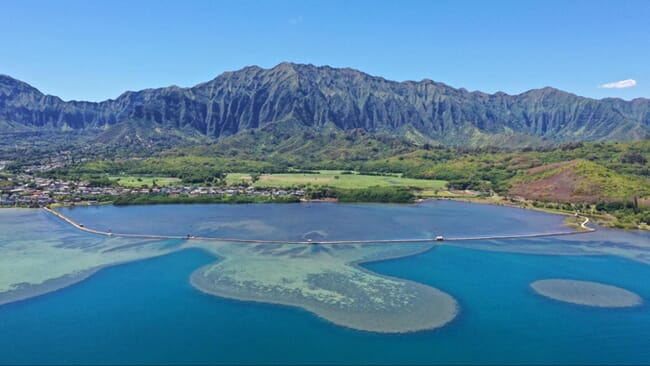
Historically these ponds yielded nearly 2 million pounds of fish across the archipelago annually © Keli'l Kotubetey
The study, published by a team of researchers at the Hawaiʻi Institute of Marine Biology (HIMB), notes that aquaculture supplies less than 1 percent of Hawaiʻi’s 70 million pounds of locally available seafood, but revitalisation of loko iʻa has the potential to significantly increase locally available seafood.
According to historical accounts, loko iʻa can create surplus fish inside the pond, but their role as a nursery ground seeding surrounding fish populations has received less attention.
“We have demonstrated the ability of Indigenous aquaculture systems to produce a surplus of fish as well as supplement fisheries in the surrounding estuary,” said lead author and marine biology PhD candidate, Anne Innes-Gold, in a press release.
“We have heard people voice the idea that, historically, loko iʻa provided nursery grounds that may have supplemented fish populations in the estuary. Our study is the first that we are aware of to demonstrate this idea in academic literature,” she added.
Hawaiʻi’s unique aquaculture system
The indigenous aquaculture systems found in Hawaiʻi boast a design found nowhere else in the world, and are among the most productive and diverse of their kind. Loko iʻa historically yielded nearly 2 million pounds of fish annually, and hoaʻāina (land tenants) and kiaʻi (caretakers) initially managed them with a “take what you need” mentality, to ensure the resource persisted. Most loko iʻa were destroyed in the 20th century, and by 1994 only six of 500 historical loko iʻa were still operating.
“As aquaculture continues to provide a growing proportion of our seafood globally, revival of Indigenous aquaculture systems will be beneficial to sustainably maintain and increase our seafood supply,” said Innes-Gold.
Restoration success
One success story of loko iʻa restoration is the Heʻeia Fishpond, located in Windward Oʻahu and stewarded by native Hawaiian nonprofit, Paepae o Heʻeia. Their mission is to link Indigenous knowledge with contemporary management to promote cultural sustainability and restore and maintain a loko iʻa for the local community. The benefits of restoring loko iʻa and related systems can help boost local food production, and promote cultural education.
This work was funded by Hawaiʻi Sea Grant, the Heʻeia National Estuarine Research Reserve, and the National Marine Fisheries Service-Sea Grant Fellowship in Population and Ecosystem Dynamics.
With their foundational work complete, Innes-Gold and her team plan to simulate potential climate change impacts in a loko iʻa system.



